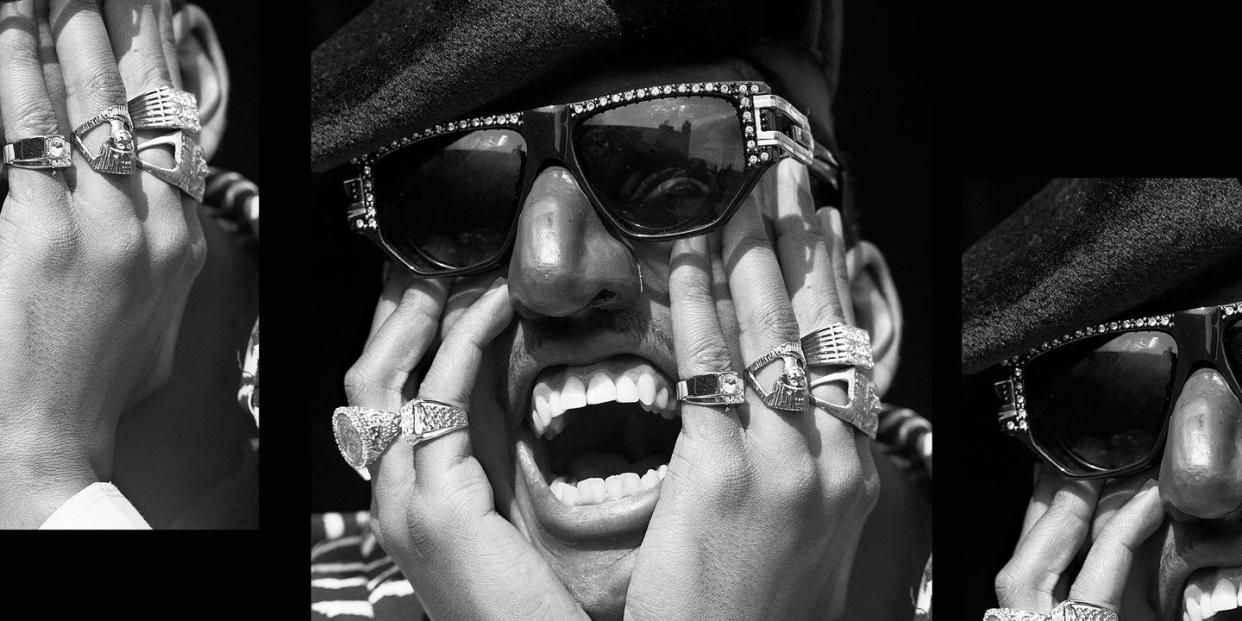Shock G and Digital Underground Could Fit Wherever You Put Them

- Oops!Something went wrong.Please try again later.
An amazing thing about listening to hip-hop in the late 1980s and early 1990s was the sense of infinite possibility. It seemed like every week, some new record came out that sounded like nothing you had ever heard before, and opened up some whole new territory you’d never even considered. The technology, the subject matter, and the audience were all shifting at warp speed; N.W.A’s Straight Outta Compton, Public Enemy’s It Takes a Nation of Millions to Hold Us Back, and De La Soul’s 3 Feet High and Rising all radically changed the direction of music, and they all came out within less than a year of each other.
Still, no one was quite ready for 1990’s Sex Packets, from a Bay Area collective calling themselves Digital Underground. It was an hour-long (even longer on the cassette version) concept album about something called "G.S.R.A." (Genetic Suppression Relief Antidotes), a pill developed by the government to provide sexual experiences in situations that would render such activity impossible or inconvenient—like astronauts in space.
It went from deep-sea gangstas—MC Blowfish!—on “Underwater Rimes” to backstage sex fantasies (“Freaks of the Industry”), complete with such unexpected musical flourishes as piano solos and Jimi Hendrix samples. And, of course, the album included the immortal “Humpty Dance,” one of rap’s all time funkiest and silliest tracks, delivered in a nasal drawl over a hypnotically slinky bass line by a character named Humpty Hump…who never seemed to appear in the same room as Digital Underground’s co-founder Shock G.
When news broke last night that Shock G (born Gregory Jacobs) was found dead at the age of 57 in a Tampa hotel room—the third major loss in hip-hop in recent weeks, following the passing of DMX and Black Rob—there was a palpable sense of fans being transported back to a remarkable era. That wild musical lawlessness would soon be overwhelmed, first by the simplified pop-rap of MC Hammer (like DU, a product of Oakland) and Vanilla Ice, and then by Dr. Dre’s brilliant fusion of street knowledge, weed, and silky beats on The Chronic. But Digital Underground persevered, maintaining a unique place in the music’s landscape.
“Most people have a checklist of what makes a good pop song,” Shock G once said. “It has to be three minutes long, it must have a repeatable chorus and it must have a catchy hook. That’s what makes music stale. We say ‘Do what feels good.’ If you like it for three minutes, then you’ll love it for 30.”
The attitude was summed up in the title of DU’s first single—“Doowutchyalike”—and it was handed down straight from one of Shock’s idols, George Clinton of Parliament-Funkadelic, with whom he later collaborated. (Bootsy Collins posted that Shock “helped keep P Funk alive!”) Prince, of course, was also a Clinton acolyte, and Shock worked with him, too: in 1994, Prince released a single called “Love Sign,” and Shock did a remix; when the song showed up on the Crystal Ball album, it included the remix.

But there’s one collaborator with whom Shock G will always be associated. Tupac Shakur’s first real break in the music business came when Digital Underground took him on tour as one of their dancers, and then gave him his first opportunity on the mic with a verse in “Same Song,” on their 1991 This is an EP Release. It was a charming few lines, if not indicative of the complex artist that followed (“Now I clown around when I hang around with the Underground…”), but it set in motion a career that changed the world. After news of Shock’s death broke, Tupac’s social media, run by his estate, posted a 1995 quote from the rapper, which reads “I look back [on my times with Shock G] with the greatest fondness. Those were like some of the best times of my life…”
Shock worked with Tupac on multiple occasions, including some of his key recordings. He co-produced Shakur’s debut album, 2Pacalypse Now, and then produced and appeared on his breakthrough single “I Get Around.” He also co-wrote and produced the emotional “So Many Tears,” from the Me Against the World album. It’s fascinating to think what Tupac absorbed from being around the Digital Underground crew, a group which initially envisioned a more political focus, inspired by the Black Panthers, but evolved into absurdist, subversive pranksters.
Back when they were being introduced to the world, I saw Digital Underground perform on some crazy bills—in between Urban Dance Squad and Modern English on a 1990 New Music Seminar show, and opening for Ice Cube in an unforgettable 1991 appearance at the Apollo Theater (“nobody had a better stage show,” Cube posted in tribute). Shock G and his alter ego fit wherever you put them.
Digital Underground released some more great singles—“Kiss You Back,” “No Nose Job”—and toured for decades before officially disbanding in 2008; Shock G released one solo album, Fear of a Mixed Planet, in 2004. The group broke ground and opened doors, illustrating the eclectic opportunity of their moment. Shock G bridged the gap from P-Funk to Tupac—and if he’s ultimately remembered for a parody dance number in which he “got busy in a Burger King bathroom,” that would be contribution enough. As he signed off at the end of that magically ridiculous anthem, “peace, and Humptiness, forever.”

Get 87 Years of Award-Winning Journalism, Every Day
Join Esquire Select
You Might Also Like

